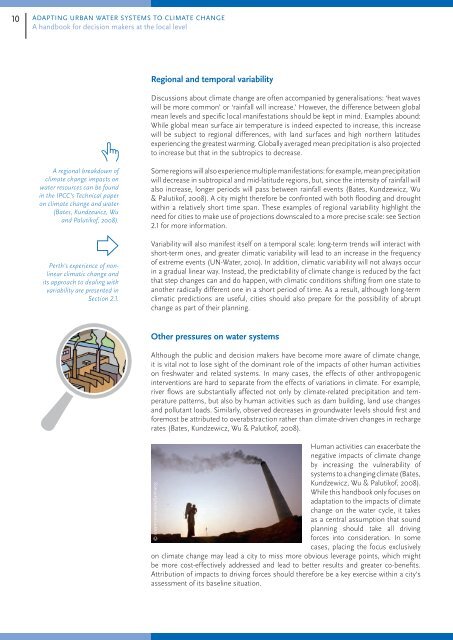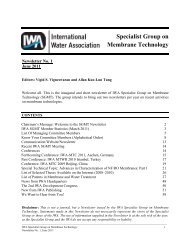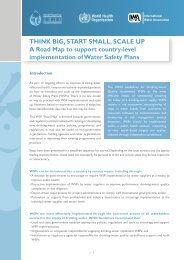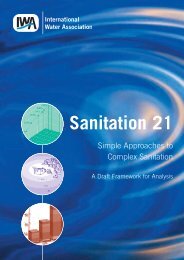AdApting urbAn wAter systems to climAte chAnge - IWA
AdApting urbAn wAter systems to climAte chAnge - IWA
AdApting urbAn wAter systems to climAte chAnge - IWA
Create successful ePaper yourself
Turn your PDF publications into a flip-book with our unique Google optimized e-Paper software.
10 Adapting urban water <strong>systems</strong> <strong>to</strong> climate change<br />
A handbook for decision makers at the local level<br />
Section 1<br />
Vulnerability of urban water <strong>systems</strong> in the face of climate change<br />
11<br />
Regional and temporal variability<br />
Discussions about climate change are often accompanied by generalisations: ‘heat waves<br />
will be more common’ or ‘rainfall will increase.’ However, the difference between global<br />
mean levels and specific local manifestations should be kept in mind. Examples abound:<br />
While global mean surface air temperature is indeed expected <strong>to</strong> increase, this increase<br />
will be subject <strong>to</strong> regional differences, with land surfaces and high northern latitudes<br />
experiencing the greatest warming. Globally averaged mean precipitation is also projected<br />
<strong>to</strong> increase but that in the subtropics <strong>to</strong> decrease.<br />
1.2 Sensitivity within urban water <strong>systems</strong><br />
Cities concentrate population, infrastructure, economic activity and wealth, and will<br />
therefore be disproportionately affected by the local impacts of climate change. In<br />
addition, cities located in coastal areas and/or on the banks of rivers are particularly<br />
vulnerable <strong>to</strong> sea level rise and flooding. Cities are also characterised by the predominance<br />
of impermeable surfaces – which are less capable of absorbing increased rainfall and<br />
therefore increase the intensity of rainfall runoff – and are prone <strong>to</strong> the urban heat island<br />
effect which amplifies heat waves.<br />
A regional breakdown of<br />
climate change impacts on<br />
water resources can be found<br />
in the IPCC’s Technical paper<br />
on climate change and water<br />
(Bates, Kundzewicz, Wu<br />
and Palutikof, 2008).<br />
Perth’s experience of nonlinear<br />
climatic change and<br />
its approach <strong>to</strong> dealing with<br />
variability are presented in<br />
Section 2.1.<br />
Some regions will also experience multiple manifestations: for example, mean precipitation<br />
will decrease in subtropical and mid-latitude regions, but, since the intensity of rainfall will<br />
also increase, longer periods will pass between rainfall events (Bates, Kundzewicz, Wu<br />
& Palutikof, 2008). A city might therefore be confronted with both flooding and drought<br />
within a relatively short time span. These examples of regional variability highlight the<br />
need for cities <strong>to</strong> make use of projections downscaled <strong>to</strong> a more precise scale: see Section<br />
2.1 for more information.<br />
Variability will also manifest itself on a temporal scale: long-term trends will interact with<br />
short-term ones, and greater climatic variability will lead <strong>to</strong> an increase in the frequency<br />
of extreme events (UN-Water, 2010). In addition, climatic variability will not always occur<br />
in a gradual linear way. Instead, the predictability of climate change is reduced by the fact<br />
that step changes can and do happen, with climatic conditions shifting from one state <strong>to</strong><br />
another radically different one in a short period of time. As a result, although long-term<br />
climatic predictions are useful, cities should also prepare for the possibility of abrupt<br />
change as part of their planning.<br />
Other pressures on water <strong>systems</strong><br />
Although the public and decision makers have become more aware of climate change,<br />
it is vital not <strong>to</strong> lose sight of the dominant role of the impacts of other human activities<br />
on freshwater and related <strong>systems</strong>. In many cases, the effects of other anthropogenic<br />
interventions are hard <strong>to</strong> separate from the effects of variations in climate. For example,<br />
river flows are substantially affected not only by climate-related precipitation and temperature<br />
patterns, but also by human activities such as dam building, land use changes<br />
and pollutant loads. Similarly, observed decreases in groundwater levels should first and<br />
foremost be attributed <strong>to</strong> overabstraction rather than climate-driven changes in recharge<br />
rates (Bates, Kundzewicz, Wu & Palutikof, 2008).<br />
Human activities can exacerbate the<br />
negative impacts of climate change<br />
by increasing the vulnerability of<br />
<strong>systems</strong> <strong>to</strong> a changing climate (Bates,<br />
Kundzewicz, Wu & Palutikof, 2008).<br />
While this handbook only focuses on<br />
adaptation <strong>to</strong> the impacts of climate<br />
change on the water cycle, it takes<br />
as a central assumption that sound<br />
planning should take all driving<br />
forces in<strong>to</strong> consideration. In some<br />
cases, placing the focus exclusively<br />
on climate change may lead a city <strong>to</strong> miss more obvious leverage points, which might<br />
be more cost-effectively addressed and lead <strong>to</strong> better results and greater co-benefits.<br />
Attribution of impacts <strong>to</strong> driving forces should therefore be a key exercise within a city’s<br />
assessment of its baseline situation.<br />
© dreamstime.com/Samrat35<br />
Finally, as population growth will overwhelmingly take place in cities, urban water<br />
managers will face a growing challenge <strong>to</strong> maintain safe and adequate water supplies and<br />
wastewater services for urban residents. Urban population growth in the next decades<br />
will take place at a very rapid scale and mostly in developing countries, exacerbating many<br />
of the problems linked <strong>to</strong> urban poverty, increasing the size of vulnerable populations in<br />
cities and placing additional pressure on dwindling supplies of resources such as water<br />
(Pageler, 2009).<br />
The vulnerability of urban water supply, wastewater and s<strong>to</strong>rmwater <strong>systems</strong> <strong>to</strong> climate<br />
change is outlined in this section. These <strong>systems</strong> will be strongly affected by the various<br />
manifestations of climate change, with impacts primarily relating <strong>to</strong> their physical infrastructure<br />
but also <strong>to</strong> their functionality.<br />
This section is supported by the table in Annex 2 which presents a selection of examples<br />
of the impacts of some predicted climate change manifestations. The table mainly<br />
focuses on urban water but also <strong>to</strong>uches upon other urban sec<strong>to</strong>rs which are strongly<br />
related <strong>to</strong> water, such as energy, health, food production and green spaces. Annex 2 is<br />
intended as an illustration of the variety of impacts which can be anticipated and of the<br />
links between the water sec<strong>to</strong>r and other urban sec<strong>to</strong>rs. This section of the handbook is<br />
also accompanied by the illustration on pages 28 and 29, which shows some of the main<br />
challenges of climate change for cities.<br />
© iS<strong>to</strong>ckpho<strong>to</strong>.com/thejack
















